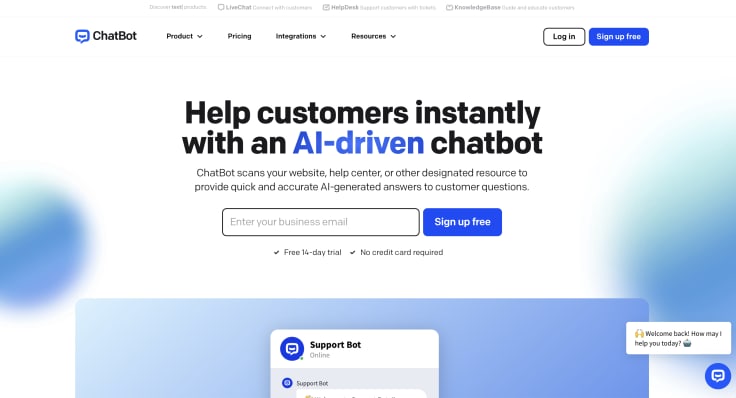Showing top 0 results 0 results found
Showing top 0 results 0 results found

There is a reason over 25% of travel and hospitality companies around the world rely on chatbots to power their customer support services. Having a clean system in place that empowers potential customers to get answers to last-minute questions before placing a booking improves sales.
Across most industries, the use of chatbots is growing. Everyone from ecommerce companies providing custom cat clothing to airlines like Southwest and Delta use chatbots to connect better with clients.
With so much use of such tech around a broad range of industries, it can be a little confusing whenever competing terms like chatbot vs. conversational AI (artificial intelligence) come up.
In this article, I’ll review the differences between these modern tools and explain how they can help boost your internal and external services.
What are chatbots?
Think of chatbots as robots with rules. These are software applications created on a specific set of rules from a given database or dataset. For example, you may populate a database with info about your new handmade Christmas ornaments product line. The rule-based chatbots respond accordingly whenever a customer asks a question with specific keywords or phrases related to that info.
Over time, you train chatbots to respond to a growing list of specific questions. An effective way to categorize a chatbot is like a large form FAQ (frequently asked questions) instead of a static webpage on your website.
Chatbots utilize natural language processing (NLP) to sound human but often falls short due to the lack of “contextual sophistication.” Instead of adapting to the market's various new and ever-changing needs, they stick to those predetermined calls and responses.
You can try out our ChatBot for FREE for 14 days and explore all the features.
What is conversational AI?
Conversational interfaces go a step further than basic chatbots. These software programs actively learn from the inputs they receive. Instead of sounding like an automated response, the conversational AI relies on artificial intelligence and natural language processing to generate responses in a more human tone.
This is an exciting part of AI design and development because it fuels the drive many companies are striving for. The dream is to create a conversational AI that sounds so human it is unrecognizable by people as anything other than another person on the other side of the chat.
With conversational AI technology, you get way more versatility in responding to all kinds of customer complaints, inquiries, calls, and marketing efforts. When a conversational AI is properly designed, it uses a rich blend of UI/UX, interaction design, psychology, copywriting, and much more.
The differences between chatbots vs, conversational AI
There are benefits and disadvantages to both chatbots and conversational AI tools. Just remember that chatbots are far more rule-based. They have to follow guidelines through a logical workflow to arrive at a response. This is like an automated phone menu you may come across when trying to pay your monthly electricity bills. It works, but it can be frustrating if you have a different inquiry outside the options available.
Conversational AI is more of an advanced assistant that learns from your interactions. These tools recognize your inputs and try to find responses based on a more human-like interaction. The more training these AI tools receive, the better ML, NLP, and other outputs are used through deep learning algorithms.
Here are some of the clear-cut ways you can tell the differences between chatbots and conversational AI.
Types of commands
Traditional rule-based chatbots only use text or push-button commands. In some rare cases, you can use voice, but it will be through specific prompting. For example, if you say, “Speak with a human,” the chatbot looks for the keywords “speak” and “human” before sending you to an operator.
Conversational AI chatbots are capable of voice, text, and other inputs and outputs. Apps like Soundhound even provide a service where you can hum in a tune, and it will respond with a song most like what you demonstrated. The Amazon Alexa you have perched on your kitchen counter is an excellent example of a conversational AI.
Where it's used
You’ll find conversational AI technology in a wide range of products. This is because it has omnichannel capabilities. Everything from integrated apps inside of websites to smart speakers to call centers can use this type of technology for better interactions.
Unfortunately, most rule-based chatbots will fall into a single, typically text-based interface.
Context
The context AI chatbots use says a lot about their differences. Traditional rule-based chatbots, through a single channel using text-only inputs and outputs, don’t have a lot of contextual finesse. You will run into a roadblock if you ask a chatbot about anything other than those rules.
Conversational AI chatbots love context. They have a much broader scope of no-linear and dynamic interactions that are dialogue-focused. That is the whole point. You want a conversational AI to be more human.
Learning at scale
If you want rule-based chatbots to improve, you have to spend a lot of time and money manually maintaining the conversational flow and call and response databases used to generate responses.
Conversational AI platforms scale with your inputs. The more your customers or end users engage with conversational interfaces, the greater the breadth of context outside a pre-defined script. That kind of flexibility is precisely what companies need to grow and maintain a competitive edge in today’s marketplace.
Benefits of implementing a conversational AI

First and foremost, implementing a conversational AI reduces the awkward conversations clients have with your brand or business. Instead of wasting time trying to decipher the pre-defined prompts or questions created by a traditional chatbot, they will get a simplified interface that responds to whatever questions they may have.
Beyond that, there are other benefits I’ve found in products like ChatBot 2.0, designed to boost your operational and customer service efficiency.
Reduce employee workload
The more your conversational AI chatbot has been designed to respond to the unique inquiries of your customers, the less your team members will have to do to manage the inquiry. Instead of spending countless hours dealing with returns or product questions, you can use this highly valuable resource to build new relationships or expand point of sale (POS) purchases.
When you integrate ChatBot 2.0, you give customers direct access to quick and accurate answers. They’ll be able to find out if that king-size bed in your boutique hotel has four hundred thread count sheets or better, instead of waking up your customer support team in the middle of the night. Such accurate and fast replies directly convert more potential customers to make a sale or secure a booking.
Aid customers through any digital roadmaps
Many businesses and organizations rely on a multiple-step sales method or booking process. That can be confusing for customers who are unused to certain technologies. A conversational AI chatbot lowers the need to intercede with these customers. It helps guide potential customers to what steps they may need to take, regardless of the time of day.
Say you have a food truck rental business operating out of Colorado. Using ChatBot 2.0 gives you a conversational AI that is able to walk potential clients through the rental process. This means the assistant securing the next food and wine festival working at 3 AM doesn’t have to wait until your regular operating hours because your system is functioning 24/7.
Cut costs and drive conversions
With less time manually having to manage all kinds of customer inquiries, you’re able to cut spending on remote customer support services. Using conversational marketing to engage potential customers in more rewarding conversations ensures you directly address their unique needs with personalized solutions. That method of personalization drives future conversions.
Even when you are a no-code/low-code advocate looking for SaaS solutions to enhance your web design and development firm, you can rely on ChatBot 2.0 for improved customer service. The no-coding chatbot setup allows your company to benefit from higher conversions without relearning a scripting language or hiring an expansive onboarding team.
Unique customer feedback and data resources
A conversational AI chatbot becomes an expert in your business, industry, and with your niche customers. It learns over time based on the various inputs provided. The results are a humanistic, 24/7 assistant your customers can rely upon.
ChatBot 2.0 doesn’t rely on third-party providers like OpenAI, Google Bard, or Bing AI. Everything is held in-house for your benefit. You get a wealth of added information to base product decisions, company directions, and other critical insights. All data is processed and hosted inside the ChatBot platform. That means fewer security concerns for your company as you scale to meet customer demand.
What are the use cases of conversational AI chatbots?
The only limit to where and how you use conversational AI chatbots is your imagination. Almost every industry can leverage this technology to improve efficiency, customer interactions, and overall productivity. Let’s run through some examples of potential use cases so you can see the potential benefits of solutions like ChatBot 2.0.
Customer service and support
Everyone from banking institutions to telecommunications has contact points with their customers. Conversational AI allows for reduced human interactions while streamlining inquiries through instantaneous responses based entirely on the actual question presented.
Ecommerce and retail
Need a way to boost product recommendations or handle spikes in demand around Black Friday? Conversational AI helps with order tracking, resolving customer returns, and marketing new products whenever possible.
Healthcare
Imagine being able to get your questions answered in relation to your personal patient profile. Getting quality care is a challenge because of the volume of doctors and providers have to see daily. Conversational AIs directly answer everything from proper medication instructions to scheduling a future appointment.
Education and human resources
Conversational AI can help with tutoring or academic assistance beyond simplistic FAQ sections. At the same time, they can help automate recruitment processes by answering student and employee queries, onboarding new hires, and even conduct AI-powered coaching.
Travel and hospitality
Get potential clients the help needed to book a kayak tour of Nantucket, a boutique hotel in NYC, or a cowboy experience in Montana. You can also gather critical feedback after the event to inform how you can change and adapt your business for futureproofing.
Entertainment and media
Streaming services like Netflix, Amazon Prime, and Hulu rely on chatbots for customer service. Upgrading to conversational AI improves recommended content, assists with subscription management, and engages users in marketing research.
IT and business operations
Streamline your internal processes like IT support, data retrieval, and governance, or automate many of the mundane, repetitive tasks your team shouldn’t be managing. These intuitive tools facilitate quicker access to information up and down your operational channels.
The list goes on and on and on. From language learning support for students preparing for a semester abroad to crisis management assistance for those overseeing an emergency. Conversational AI chatbots allow for the expansion of services without a massive investment in human assets or new physical hardware that can eventually run out of steam.
The future of chatbots vs. conversational AI solutions
As you can see, the future of conversational AI is bright. More and more businesses will move away from simplistic chatbots and embrace AI solutions supported with NLP, ML, and AI enhancements. You’re likely to see emotional quotient (EQ) significantly impacting the future of conversational AI. Empathy and inclusion will be depicted in your various conversations with these tools.
The more personalization impacts AI, the greater the integration with responses. AI chatbots will use multiple channels and previous interactions to address the unique qualities of an individual’s queries. This includes expanding into the spaces the client wants to go to, like the metaverse and social media.
Contextual awareness is only going to grow stronger. Companies want AI assistants to deliver more responsive outcomes that drive conversions and lead customers back around to making a sale or securing a booking. The greater the contextual awareness, the more accurate the information being provided for the user.
With that context comes intuitive and complex understanding. I see this the most in voice assistants using conversational AI. The unique language patterns of users vary dramatically. These tools must adapt to clients' linguistic details to expand their capabilities.
Simply put, the future will be convenient. We can already ask our phones for the day’s weather from across the room. Imagine what tomorrow’s conversational AI will do once we integrate many of these adaptations.
Conclusion
Chatbot vs. conversational AI can be confusing at first, but as you dive deeper into what makes them unique from one another, the lines become much more evident. ChatBot 2.0 is an example of how data, generative large language model frameworks, and advanced AI human-centric responses can transform customer service, virtual assistants, and more.
Sign up for your free account with ChatBot and give your team an empowering advantage in sales, marketing, and customer service. This is a standalone AI system you control with advanced security for peace of mind.
When you want a data-driven, AI-powered conversational AI managed by your team, you want ChatBot 2.0.


